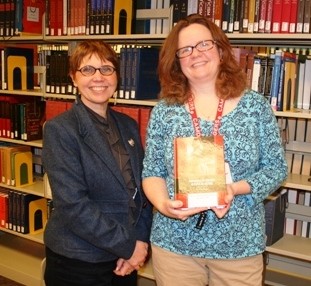Librarian's Research Focuses on Child Stars of Viral Videos
Rutgers-Camden's Katie Elson Anderson examines exploitation

Child-centric viral videos are turning young stars into internet sensations, but a Rutgers–Camden researcher warns against exploiting the children by cashing in on the fame.
“We just don’t know what kinds of affect this internet fame will have on these children in the future,” says Katie Elson Anderson, a librarian at the Paul Robeson Library on the Rutgers–Camden campus.
Anderson has examined the implications of the YouTube videos for her essay, “Configuring Childhood on the Web,” which is featured as a chapter in the book Portrayals of Children in Popular Culture: Fleeting Images (Lexington Books, 2012).
“Viral videos starring children have become a real phenomenon,” Anderson says.
“David After Dentist,” the video in which a father taped his young son dealing with the effects of anesthesia, has been viewed more than 117 million times. “Charlie Bit My Finger,” in which a baby boy bites his big brother, has been seen more than 511 million times.
“I think the early videos — the ones with Charlie and David, for example — were organic,” Anderson says. “People didn’t really know that these videos could become viral. They just posted videos for family. Now, it seems that people are posting videos because they are seeing the fame that can result from it. There’s actually money to be made.”
In her essay, Anderson notes that technological advances have made it easier to capture childhood memories and people are now “sharing images of their children with an expanding audience, making private moments more public.”
Parents can cash in on the fame by entering partnerships with YouTube and pocketing a chunk of the site’s ad revenue. Some videos, like the dad and daughter duet that covered the song “Home,” have led to appearances in commercials. Others sell their own merchandise.
Child actors have been ingrained in popular culture for decades. Shirley Temple, Ron Howard, and Mary Kate and Ashley Olsen grew up in front of Americans on television and movie screens. Anderson says that the young stars of YouTube videos are approaching similar levels of fame, but unlike child actors, they aren’t protected by laws that require some of the money be set aside.
Vibiana Bowman Cvetkovic, a Rutgers–Camden librarian who co-edited Portrayals of Children in Popular Culture: Fleeting Images, She says when a video featuring a child is uploaded to the Internet, the child becomes a commodity.
“Katie’s research brings up moral, ethical, philosophical, and legal questions that have been floating around ever since people have been capturing images of children,” Cvetkovic says. “With new media, people want to experience instant gratification, but many of these children aren’t old enough to understand the implications.”
Reality television programming and viral videos have thrust children into the spotlight in ways TV comedies, dramas, or variety shows couldn’t because viewers are able to peek into a child’s personal life.
“Everyone is interested in having their fame and social media makes it quick and easy,” Anderson says. “But no one is asking their adorable 9-year-old if they want to be on YouTube.”
Portrayals of Children in Popular Culture: Fleeting Images is a collection of essays that examine the images of children and childhood in popular culture, in print, online, and in television and film.
Anderson received her master’s degree in library and information science from Rutgers University in New Brunswick. Her research focuses on social media and education.
Cvetkovic is a Philadelphia resident and a member of the Broadcast Pioneers of Philadelphia, a nonprofit organization that promotes broadcast-related causes and preserves the history of television and radio in Philadelphia. She is a doctoral student in Rutgers–Camden’s childhood studies program who is writing her dissertation on children and television.
-30-
Media Contact: Ed Moorhouse
(856) 225-6759
E-mail: ejmoor@camden.rutgers.edu